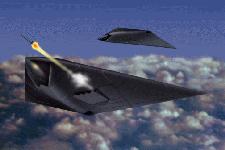
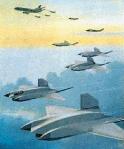
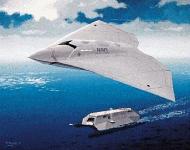

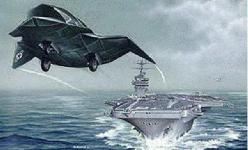

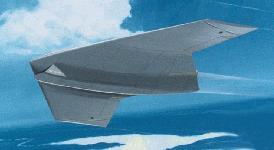
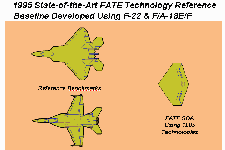

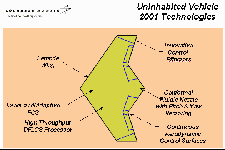
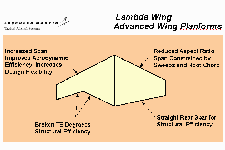



The Unmanned Combat Air Vehicle vision is an affordable weapon system that expands tactical mission options for revolutionary new air power as an integrated part of a system of systems solution. The UCAV weapon system will exploit the design and operational freedoms of relocating the pilot outside of the vehicle to enable a new paradigm in aircraft affordability while maintaining the rationale, judgment, and moral qualities of the human operator. In our vision, this weapon system will require minimal maintenance, can be stored for extended periods of time, and is capable of dynamic mission control while engaging multiple targets in a single mission under minimal human supervision. The UCAV will conduct missions from ordinary airfields as part of an integrated force package complementary to manned tactical and support assets. UCAV controllers will observe rules of engagement and make the critical decisions to use or refrain from using force.
The initial operational role for the UCAV is a "first day of the war" force enabler which complements a strike package by performing the SEAD mission. In this role, UCAVs accomplish preemptive destruction of sophisticated enemy integrated air defenses (IADs) in advance of the strike package, and enable the attacking forces by providing reactive suppression against the remaining IADs. Throughout the remainder of the campaign, UCAVs provide continuous vigilance with an immediate lethal strike capability to prosecute high value and time critical targets. By effectively and affordably performing those missions the UCAV system provides "no win" tactical deterrence against which an enemy's defenses would be ineffective, thereby ensuring air superiority.
As a member of a tightly coupled system of systems, the UCAV will work cooperatively with manned systems and exploit the emerging command, control, communications, computer, intelligence, surveillance and reconnaissance (C4ISR) architecture to enable successful achievement of campaign and mission level objectives. Intelligence preparation of the battlefield will provide an initial mission/threat database for mission controllers. Controllers will exploit real-time data sources from the theater information architecture to plan for, and respond to, the dynamically changing battlefield. The UCAV will penetrate enemy IADs and external systems such as the Miniature Air Launched Decoy (MALD) will stimulate potential targets. Sensor cueing and off-board targeting can be provided by national systems or airborne assets in real time and/or UCAVs may be part of multi-ship Time Difference of Arrival (TDOA) targeting architectures. The system will create superior situation awareness by leveraging the many sources of information available at both the tactical and theater levels.
Such a UCAV weapon system has the potential to fully exploit the emerging information revolution and provide advanced airpower with increased tactical deterrence at a fraction of the total Life Cycle Costs (LCC) of current manned systems. The government envisions a UCAV Operational System (UOS) air vehicle with unit cost less then one-third of the Joint Strike Fighter, and reduction in total life cycle of 50-80% compared to a current tactical aircraft squadron.
A variety of cost and weight penalties are associated with the presence of a human pilot, including constrained forebodies, large canopies, displays and environmental control systems. The aircraft's maneuver capabilities are limited by the pilots physiological limits such as g tolerance. Removing the pilot from the vehicle eliminates man-rating requirements, pilot systems, and interfaces. The UCAV offers new design freedoms that can be exploited to produce a smaller, simpler aircraft, about half the size of a conventional fighter aircraft. Weighing about one-third to one-fourth of a manned aircraft, at 10,000 pounds they would weigh two to three times more than a Tomahawk missile.
Typically 80 percent of the useful life of today's combat aircraft is devoted to pilot training and proficiency flying, requiring longer design lives than would be needed to meet combat requirements. Without the requirement to fly sorties to retain pilot proficiency, UCAVs will fly infrequently. A reduced maintenance design with condition based maintenance, minimized on-board sensors, reduced fluid systems, maintainable signature, and a modular avionics architecture will reduce touch labor in the fashion of commercial aircraft.
Advances in small smart munitions will allow these smaller vehicles to attack multiple targets during a single mission and reduce the cost per target killed. The Miniaturized Munitions Technology Demonstration (MMTD) goal is to produce a 250-pound class munition effective against a majority of hardened targets previously vulnerable only to 2,000-pound class munitions. A differential GPS/INS system will provide precision guidance, and smart fusing techniques will aid in producing a high probability of target kill.
The DARPA/Air Force/Boeing X-45A technology demonstration aircraft completed its first flight on 22 May 2002. Multi-aircraft testing will begin in 2003 when a second X-45A becomes operational, leading to joint UCAV and manned exercises in FY 2006.










